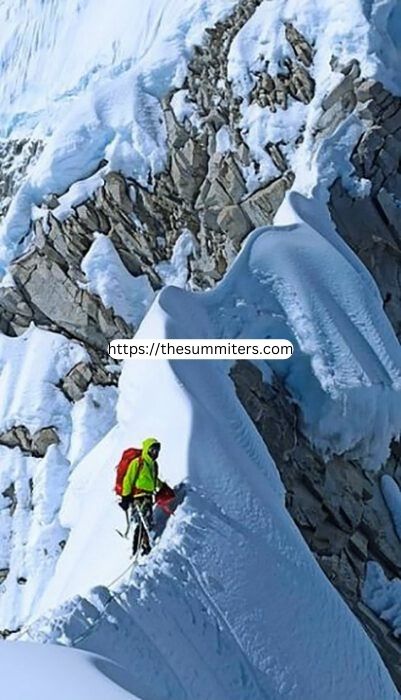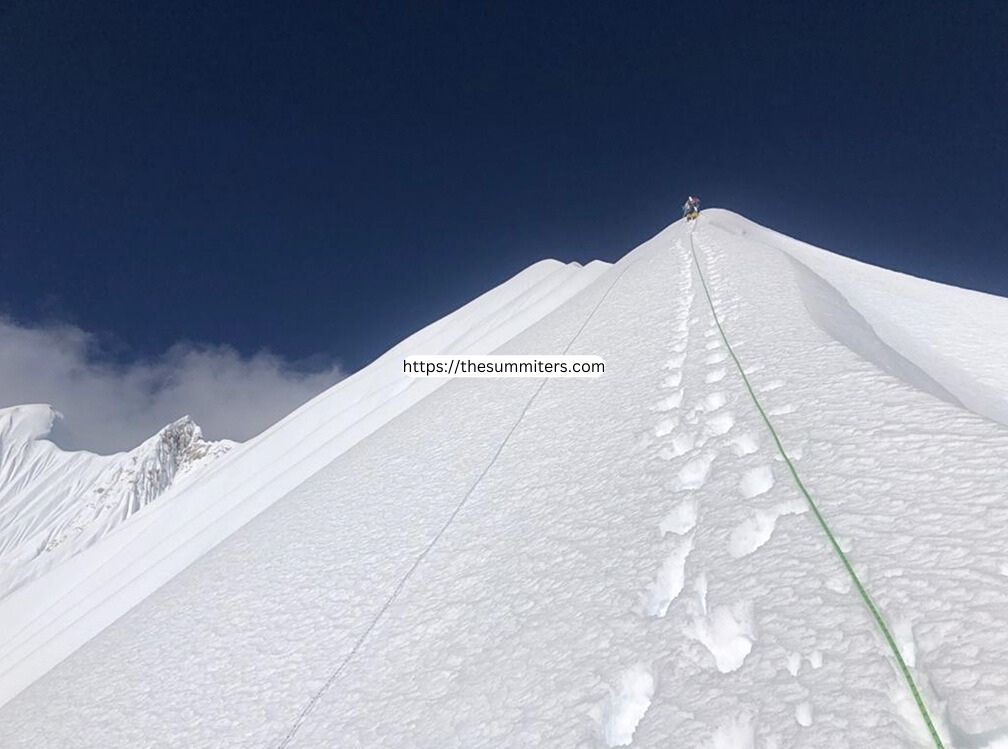A team of Russian climbers, led by Andrey Vasiliev, has made remarkable progress on the south side of Cho Oyu, and they’re now tantalizingly close to reaching the summit. What makes this expedition stand out is their daring attempt on the challenging SSW (or SW) ridge of the mountain. What’s even more impressive is that they’re doing it without the use of supplementary oxygen or the support of sherpas, a feat never accomplished before.

The team, comprising five dedicated climbers, employed their tried-and-true strategy of working in shifts and splitting into two groups. Two members, Sergey Kondrashkin and Vitaly Shipilov, reached the pivotal Lungsampa point at 6,528m, a crucial juncture on the route that must be overcome to access a high plateau. From there, they faced another steep section leading up to the summit headwall.
Post conquering Lungsampa, the climbers pressed on along the ridge, encountering their first significant challenge at the first gendarme. The terrain proved to be technically demanding, with sharp edges, steep drops in both directions, and treacherous cornices on the south side. Climbers had to carefully navigate through a meter of snow, likening it to a cautious crawl along a fence.
A Final Summit Remains | Russian Climbers
The second group, made up of Andrey Vasiliev, Victoria Klimenko, and Kirill Eizerman, provided invaluable support by hauling heavy loads up to an elevation of 6,400m. The lead group successfully surmounted the ridge, triumphing over two more gendarmes before reaching the plateau at 6,600m.
Upon reaching the plateau, they made their way towards the southern ridge of Cho Oyu, which serves as the boundary between Tibet and Nepal. They spent the night at an elevation ranging from 7,050m to 7,100m. This leg of the climb presented fewer technical challenges, offering the climbers their first glimpse of the ultimate headwall leading to the summit. Unfortunately, adverse weather conditions set in the following day.
The climbers found themselves in a complete whiteout, compelling them to rely on GPS for orientation as they made their way back to their tents on the far side of the plateau. The next day, they descended and returned to Gokyo to rest and await more favorable weather conditions.
This recent venture on Cho Oyu’s SSW ridge follows two earlier attempts by a Nepalese team led by Mingma Dorchi Sherpa. The Nepal’s team reached an elevation of 7,700m on their first try in winter and reached as far as Camp 3 at 7,200m on their second attempt. It’s worth noting that there is a slight distinctness in altitude estimates between different teams with the Russian team placing the plateau between 6,600m and 7,100m.
Tragedy struck the expedition when Nadya Oleneva met a tragic end in a fatal fall on Dhaulagiri. This deeply affected the Cho Oyu team. While there were discussions about airlifting the team to Dhaulagiri to recover her body, the risks involved were ultimately deemed too great. A helicopter conducted an overflight of the accident site, but Oleneva’s body now rests beneath fresh snow. Team leaders Roman Abildaev and Rasim Kashapov are presently in Kathmandu, managing the necessary formalities related to this heartbreaking incident.
Over View | Mt Cho Oyu
Cho Oyu! Affectionately known as the “Turquoise Goddess” privileges the heart of the Himalayas as the World’s sixth Highest peak. Its royal presence straddles the border between Nepal and Tibet soaring to an impressive altitude of 8,188 meters (26,864 feet) above sea level. Cho Oyu is celebrated not only for its prominent beauty but also for its close proximity to the renowned Mount Everest as if the two peaks were neighbors separated by just a stones throw. This adjacency makes Cho Oyu an irresistible draw for adventurous souls and climbers looking to test their mettle on one of Earth’s loftiest summits while savoring the awe-inspiring Himalayan vistas.

The mountain’s name, “Cho Oyu,” originates from the Tibetan language and translates to “Turquoise Goddess.” This moniker suits it well, given the dazzling icy features that embellish its slopes, resembling the precious gem from which it takes its name. Beyond its aesthetics, Cho Oyu has earned a reputation as one of the more approachable 8,000-meter peaks, making it an enticing choice for mountaineers eager to challenge themselves in high-altitude settings.
Unlike its more daunting neighbors, such as K2 or Annapurna, Cho Oyu is recognized for its comparatively less intricate climbing hurdles. Nevertheless, it’s no walk in the park. Those embarking on the journey to conquer Cho Oyu must grapple with brutal weather, treacherous crevasses, icy cascades, and steep, frozen slopes. Conquering this peak demands extensive preparation, prior experience, and acclimatization to the extreme altitudes.
One notable facet of Cho Oyu is the variety of routes available to climbers. The North-West ridge from Tibet and the South-West face from Nepal are among the most favored paths. The South-West face, in particular, has been gaining attention in recent times, as climbers seek to navigate its challenging course.
Over the years, Cho Oyu has borne witness to numerous expeditions, with adventurers from all corners of the globe striving to reach its summit and etch their names alongside those who dared to venture into its icy heights. The mountain’s allure transcends the ascent itself; it encompasses the spirit of adventure, cultural immersion, and the enduring beauty of the Himalayan landscapes. Cho Oyu stands as a symbol of human endeavor, beckoning thrill-seekers to pursue their dreams on its lofty slopes while being humbled by the majesty of the Himalayas.
South West Rigged
The South-West Ridge of Cho Oyu presents itself as a prominent and demanding pathway to conquer the majestic mountain, famously known as the “Turquoise Goddess” of the Himalayas. Cho Oyu, soaring as the sixth-highest peak on Earth at 8,188 meters (26,864 feet) above sea level, provides a range of options for climbers, and the South-West Ridge stands out as a formidable choice for those seeking a challenging mountaineering experience.
This route embarks from the Nepalese side of Cho Oyu, with adventurers commencing their journey from the picturesque village of Gokyo. The expedition typically kicks off with a trek through the breathtaking landscapes of the Gokyo Valley, offering climbers an opportunity to acclimatize to the high-altitude conditions while surrounded by pristine alpine lakes and awe-inspiring mountain scenery. As they progress deeper into the Khumbu region, climbers ultimately arrive at the Cho Oyu Base Camp, serving as the springboard for their ascent.
The South-West Ridge route is celebrated for its steep and technical complexities, which rigorously assess climbers’ expertise, stamina, and unwavering resolve. It is characterized by steep snow and ice slopes, treacherous crevasses, and icefalls, injecting an element of adventure and risk into the expedition. Climbers must be exceptionally prepared and equipped to confront the challenging conditions and the swiftly shifting weather patterns that are common in the high-altitude Himalayan environment.
A significant landmark along this route is Lungsampa, a pivotal point situated at an elevation of 6,528 meters. Climbers must overcome this obstacle to access the high plateau. Beyond Lungsampa, they proceed along the ridge, encountering a series of gendarmes that present technical challenges. The ridge itself is sharp and steep, demanding cautious navigation and adept ice and snow climbing. The South-West Ridge not only tests climbers physically but also challenges them mentally, as cornices on the south side add an additional layer of complexity to the ascent.
Despite its formidable nature, the South-West Ridge rewards climbers with an unmatched sense of accomplishment and a rare chance to witness the natural splendor of the Himalayas up close. As they ascend higher, they eventually reach the summit headwall, offering a clear view of the ultimate objective: the summit of Cho Oyu.
The South-West Ridge serves as a attraction for experienced mountaineers from across the world persuaded by the combination of technical challenges and the breathtaking scenery of the Himalayan region. It stands as a tribute to human endurance and the unconquerable spirit of adventure, providing climbers with a unique opportunity to push their limits and explore the stunning wilderness of the high Himalayas.